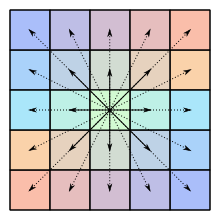Central symmetric matrix
In mathematics, a centrally symmetric matrix is a square matrix that is point-symmetric with respect to its center point. Centrally symmetric matrices occur, among other things, in the numerical solution of certain differential equations and in the investigation of Markov processes .
definition
A square matrix over a body is called centrally symmetric if for its entries
for applies. The entries of a centrally symmetric matrix do not change if they are mirrored at the center of the matrix.
Examples
Centrally symmetric matrices of size have the general shape
and those of size the shape
with .
properties
Symmetries
With the permutation matrix defined by
centrally symmetric matrices can also be made compact by the condition
characterize. A centrally symmetric matrix that is also symmetric or persymmetric is called a bisymmetric matrix . Bisymmetric matrices are both as to its main diagonal , as well as with regard to their anti-diagonal symmetrical.
Block structure
Centrally symmetric matrices with an even number of rows and columns have a special block structure of the form
- ,
where are. Centrally symmetric matrices with an odd number of rows and columns have the structure
- ,
wherein , , and are.
Eigenvalues
The eigenvalues of a centrally symmetric matrix with an even number of rows and columns are then given as the eigenvalues of the matrices
- and .
The corresponding eigenvectors then have the form
- and ,
where is an eigenvector of and an eigenvector of . For centrally symmetric matrices with an odd number of rows and columns, the eigenvalues are given as the eigenvalues of the matrices
- and .
The corresponding eigenvectors then have the form
- and ,
where is an eigenvector of and an eigenvector of .
Sum and product
The sum of two centrally symmetric matrices and again results in a centrally symmetric matrix, also scalar multiples are with . Since the zero matrix is trivially symmetric, the symmetric matrices form a sub-vector space in the matrix space .
The product of two centrally symmetric matrices also results in a centrally symmetric matrix, because it holds
- .
Since the identity matrix is also centrally symmetric, the centrally symmetric matrices form a subalgebra of the associative algebra of the square matrices.
Inverse
The inverse of a regular centrally symmetric matrix is again centrally symmetric because it holds
- .
The regular centrally symmetric matrices thus form a subgroup of the general linear group .
Applications
Centrally symmetric matrices occur, for example, in the numerical solution of certain differential equations and eigenvalue problems, in the investigation of Markov processes and in a number of physical problems.
See also
literature
- Roger A. Horn, Charles R. Johnson: Matrix Analysis . Cambridge University Press, 2012, ISBN 978-0-521-83940-2 .
Individual evidence
- ^ Thomas Muir: A Treatise on the Theory of Determinants . Dover, New York 1960, pp. 19 .
- ^ A b Roger A. Horn, Charles Johnson: Matrix analysis . Cambridge University Press, 2013, pp. 36 .
- ↑ Iyad T. Abu-Jeib: Centrosymmetric matrices: Properties and on Alternative Approach . In: Canadian Applied Mathematics Quarterly . tape 10 , no. 4 , 2002, p. 431 .
- ↑ Alan L. Andrew: Eigenvectors of Certain matrices . In: Linear Algebra and Applications . No. 7 , 1973, p. 157-162 .
- ↑ James R. Weaver: Centrosymmetric (cross-symmetric) matrices, their basic properties, eigenvalues, and eigenvectors . In: American Mathematical Monthly . No. 92 , 1985, pp. 711-717 .
- ^ Lokesh Datta, Salvatore D. Morgera: On the reducibility of centrosymmetric matrices — applications in engineering problems . In: Circuits Systems and Signal Processing . No. 8 , 1989, pp. 71-96 .
Web links
- Eric W. Weisstein : Centrosymmetric Matrix . In: MathWorld (English).










































